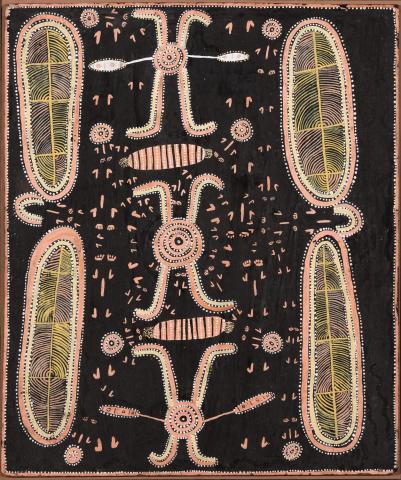MALA (SPINIFEX WALLABY), 1972
LONG JACK PHILLIPUS TJAKAMARRA
synthetic polymer powder paint on composition board
60.5 x 51.0 cm
bears inscription verso: Stuart Art Centre cat. 18030
Painted at Papunya in 1972
Stuart Art Centre, Alice Springs (consignment 18, painting 30)
Margaret Carnegie, Melbourne
Lauraine Diggins Fine Art, Melbourne (label attached verso)
Private collection, Michigan, USA
Sotheby’s, Melbourne, 29 June 1998, lot 100 (as ‘Mala (Hare Wallaby)’)
Private collection, Sydney
A Myriad of Dreaming, Twentieth Century Aboriginal Art, Lauraine Diggins Gallery, Melbourne, 18 September – 1 October 1989, Westpac Gallery, Melbourne, 4 – 22 October 1989, cat. 50 (as ‘Wallaby Dreaming, c. 1972’)
Tjukurrtjanu: Origins of Western Desert Art, National Gallery of Victoria, Melbourne, 30 September – 12 February 2011; Musée Quai Branly, Paris, 9 October 2012 – 20 January 2013 (label attached verso)
A Myriad of Dreaming, Twentieth Century Aboriginal Art, Malakoff Fine Arts Press, Melbourne, 1989, cat. 50, p. 53 (illus., as ‘Wallaby Dreaming, c. 1972’)
Bardon, G., and Bardon, J., Papunya: A Place Made After the Story – The Beginnings of the Western Desert Painting Movement, The Miegunyah Press, Melbourne, 2004, painting 364, p. 404 (illus., as ‘Mala (Hare Wallaby) Dreaming’)
Ryan, J., and Batty, P., Tjukurrtjanu: Origins of Western Desert Art, National Gallery of Victoria, Melbourne, 2011, p. 296
Long Jack Phillipus Tjakamarra’s Mala (Spinifex Wallaby), 1972 bears the hallmarks of being created in the Men’s Painting Room at Papunya in the first half of 1972. It was in this darkened space, excised at the eastern end of the Papunya Town Hall, where new elements coalesced with ancient iconography to become Western Desert art.
Phillipus grew up in the bush before coming into Haasts Bluff as a teenager. He was equally at home with Ngaliya/Warlpiri artists, such as Kaapa Tjampitjinpa, as he was with his Pintupi classificatory uncle, Uta Uta Tjangala. The symmetrical composition, and painted ‘frame’ of Mala (Spinifex Wallaby) suggests Kaapa’s strong influence.
Mala (Spinifex Wallaby) encapsulates an episode on the ceremonial ground. The bipedal tracks of the Mala, ‘hopping’ from the periphery to the centre, conveys the paths of the performers, their slowing gait evident from the marks left by their ‘tails’, and the impressions made by their front ‘paws’. The central roundel represents the epicentre of the ceremony. The performers are inferred by the presence of their body paint, extending in bands from the stomach, up their chests and over the shoulders. Similar figures, at the top and bottom, are visualised with bullroarers, (attached on taut strings). The uncanny thrum created by bullroarers is intended to forewarn the uninitiated to remain clear of the proscribed area. The large ovals in each quadrant are likely to represent the areas in which post-initiate novices are held, while learning the songs, designs and dances associated with the Mala ceremonies.
Mala (Spinifex Wallaby) was created before the controversy that erupted at the Yuendumu sports weekend in August 1972. The cause of the outcry was a group of Papunya paintings, which included restricted ceremonial detail, on public display. This painting’s candid intent is evident from the clarity and specificity of its individual elements. The unadorned black background that distinguishes such early works is also distinct. Later, the iconography would become more cryptic and enmeshed in dotted fields. The current work was produced at a unique moment when the language of Papunya painting was still at play.
JOHN KEAN
